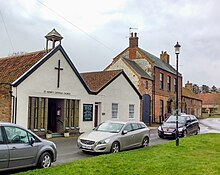Burnham Market: Difference between revisions
→History: tidied History section, removed unverifiable information (links expired) |
|||
| Line 40: | Line 40: | ||
In 1952, the [[West Norfolk Junction Railway]], which ran through the village, was closed. This railway had linked with [[Holkham]], [[Wells-next-the-Sea]], [[Hunstanton]] and [[Kings Lynn]]. The [[Burnham Market railway station|station]] still stands on the road to [[North Creake]]. |
In 1952, the [[West Norfolk Junction Railway]], which ran through the village, was closed. This railway had linked with [[Holkham]], [[Wells-next-the-Sea]], [[Hunstanton]] and [[Kings Lynn]]. The [[Burnham Market railway station|station]] still stands on the road to [[North Creake]]. |
||
==Governance== |
|||
Burnham is the name of the [[Wards and electoral divisions of the United Kingdom|electoral ward]] that covers all the Norfolk Burnhams and surrounding areas. The total population at the 2011 census was 1,714.<ref>{{Cite web |url=http://www.neighbourhood.statistics.gov.uk/dissemination/LeadKeyFigures.do?a=7&b=13693578&c=PE31+8HW&d=14&e=62&g=6449049&i=1001x1003x1032x1004&m=0&r=0&s=1440671396166&enc=1 |title=Burnham ward population 2011 |access-date=27 August 2011}}</ref> |
|||
[[File:St_Henry_Walpole_Catholic_Church,_Burnham_Market.jpg|thumb|St Henry Walpole Catholic Church, Burnham Market in the Diocese of East Anglia]] |
[[File:St_Henry_Walpole_Catholic_Church,_Burnham_Market.jpg|thumb|St Henry Walpole Catholic Church, Burnham Market in the Diocese of East Anglia]] |
||
[[File:Burnham_Market.jpg|thumb|Burnham Market]] |
[[File:Burnham_Market.jpg|thumb|Burnham Market]] |
||
Revision as of 22:43, 14 November 2022
| Burnham Market | |
|---|---|
 St Mary's parish church | |
Location within Norfolk | |
| Area | 18.43 km2 (7.12 sq mi) |
| Population | 877 (2011 Census) |
| • Density | 48/km2 (120/sq mi) |
| OS grid reference | TF834422 |
| Civil parish |
|
| District | |
| Shire county | |
| Region | |
| Country | England |
| Sovereign state | United Kingdom |
| Post town | Kings Lynn |
| Postcode district | PE31 |
| Dialling code | 01328 |
| Police | Norfolk |
| Fire | Norfolk |
| Ambulance | East of England |
| UK Parliament | |


Burnham Market is an English village and civil parish near the north coast of Norfolk. It is one of the Burnhams, a group of three adjacent villages that were merged: Burnham Sutton, Burnham Ulph and Burnham Westgate. Burnham Market was rated among the "20 most beautiful villages in the UK and Ireland" by Condé Nast Traveler in 2020.[1]
Geography
According to the 2011 Census, Burnham Market had a population of 877 people[2], which fell to 724 people by the 2021 Census.[3]
The parish belongs to the district of King's Lynn and West Norfolk.[4]
History

Burnham Market's name is of Anglo-Saxon origin and derives from the Old English for settlement on the River Burn where there is a market.[5]

In 1952, the West Norfolk Junction Railway, which ran through the village, was closed. This railway had linked with Holkham, Wells-next-the-Sea, Hunstanton and Kings Lynn. The station still stands on the road to North Creake.


Burnham Westgate Hall
Burnham Westgate Hall is a Grade II* listed Georgian country house, built in 1783–1785 by Sir John Soane, for Thomas Pitt, 1st Baron Camelford.[6] It was a remodelling of the original Polstede Hall, which had been built in the 1750s by Matthew Brettingham for Pitt's father-in-law, Pinckney Wilkinson, MP for Old Sarum. In 1783, Wilkinson gave the house to his daughter, Anne, on her marriage to Pitt.
In 1808, the Hall was purchased by Sir Mordaunt Martin.
In 1933, the house passed to the Royal British Legion. After World War II, it was used as an old people's home until 1990. Recently it has been the home of Baroness Rawlings.[7]
Novelists
The novelist sisters Anne Elliot and Emma (writing as Margery Hollis) were living in Burnham Sutton by 1901. Anne Elliot died there in 1941.[8]
Churches
The village has two Church of England churches. The larger is St Mary's, Westgate, at the west end of the marketplace. All Saints' is at the eastern end of the village – Sutton-cum-Ulph, as it incorporated the parish and some of the stone of St Ethelbert's at Burnham Sutton, some 400 yards to the south, when Horatio Nelson's father Edmund was rector of both in the 1760s and 1770s. A third parish church near Burnham Market is St Margaret's, in the neighbouring parish of Burnham Norton. Its benefice was joined with St Mary's (Westgate) to form the new ecclesiastical parish of Burnham Market in 2012. The former churches and congregations of Burnham Overy and Burnham Thorpe (Nelson's birthplace), now form a single benefice.[9]
There are two other places of worship in the village: a Roman Catholic church dedicated to St Henry Walpole and a Methodist church. The former Gospel Hall was put up for sale in 2015.
References
- ^ "THE 20 MOST BEAUTIFUL VILLAGES IN THE UK AND IRELAND, 20 October 2020". Retrieved 14 March 2021.
- ^ City Population. (2022). Retrieved November 14, 2022. https://www.citypopulation.de/en/uk/eastofengland/norfolk/E34001083__burnham_market/
- ^ Ibid
- ^ Office for National Statistics & Norfolk County Council (2001) Census population and household counts for unparished urban areas and all parishes. Retrieved 18 October 2005.
- ^ University of Nottingham. (2022). Retrieved November 14, 2022. http://kepn.nottingham.ac.uk/map/place/Norfolk/Burnham%20Thorpe
- ^ "Burnham Westgate Hall" (PDF).
- ^ Churchill, Penny (2011). "An exceptional country estate in Norfolk". Country Life.
- ^ Victorian Fiction Retrieved 14 May 2018.
- ^ Burnhams Benefice Parish. Churches; Church Locations. Retrieved 28 August 2017
External links
- Map sources for Burnham Market
- Burnham Market Village Plan, with detailed Ordnance Survey map
- Information from Genuki Norfolk on Burnham Market.

